This document discusses the challenges of maintaining atomicity in distributed database systems, specifically focusing on atomic commit protocols (ACPs) and the cost added to transaction execution. It highlights an optimization method allowing early release of read locks to enhance concurrency but warns of potential execution infections leading to non-serializable executions when deferred consistency constraints are present. The proposed unsolicited deferred consistency constraints validation (UDCCV) mechanism aims to mitigate these issues by detecting and preventing susceptible transactions from using the optimization, thus ensuring database consistency.
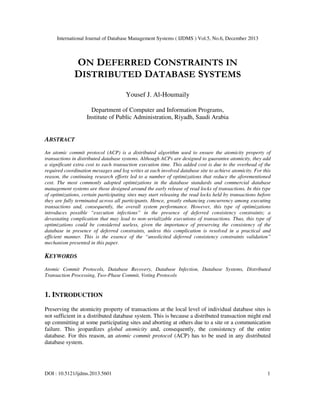
![International Journal of Database Management Systems ( IJDMS ) Vol.5, No.6, December 2013
An ACP is essentially a distributed synchronization algorithm that guarantees a unanimous and
deterministic final outcome for each distributed transaction. This outcome represents either the
execution of a transaction as a whole, across all participating sites, or none at all.
ACPs, such as the basic two-phase commit (2PC) [1, 2] or one of its widely known variants (see
[3, 4] for surveys of the most common 2PC variants and optimizations), ensure atomicity but with
a significant extra cost added to each transaction execution time. This added cost is due to the
overhead of the required coordination messages and log writes at each involved database site to
achieve atomicity. To minimize the adverse effects of this overhead on the overall system
performance, there is a continuing interest in developing more efficient ACPs and optimizations,
albeit for different distributed database system environments with inherently different
characteristics. These include main memory databases (e.g., [5]), mobile and ad hoc networks
(e.g., [6, 7, 8] ), real-time databases (e.g., [9, 10, 11]) and component-based architectures (e.g.,
[12]); besides traditional distributed database systems (e.g., [3, 13]).
One of the most notable results of these continuing efforts is a type of optimizations in which
transactions are allowed to release their read locks at certain participants before they have fully
terminated across all participants. An example to this type of optimizations is the (traditional)
read-only optimization [14]. This optimization is considered one of the most pronounced
optimizations and is currently part of the distributed database standards [15]. In this optimization,
an exclusively read-only participant in a transaction execution terminates the transaction and
releases the read locks held on behalf of the transaction before the transaction has fully
terminated at the update participants. Hence, this early release of read locks at readonly
participants significantly enhances concurrency among executing transactions and, consequently,
the overall system performance. This is especially important considering that read-only
transactions (i.e., retrieval transactions that do not contain any update operations) are the majority
of executing transactions in any general database management system. The performance
enhancement of the read-only optimization on the overall system performance has been addressed
in a number of simulation studies (e.g., [4, 16]) although basic analytical evaluations can still
reveal the fact of enhanced performance using this optimization (e.g., [14]).
In spite of the significance of the above type of optimizations on the overall performance of
distributed database systems, its applicability is curtailed due to the fact that it may lead to
nonserializable executions of transactions. This is a devastating possibility which could occur
whenever transactions are allowed to continue to execute at some participants, acquiring further
locks, after they have already terminated at others [15, 17]. These possible infected executions of
transactions at individual participating sites cannot be captured by any (local) concurrency control
mechanism without a sort of an additional global synchronization mechanism among all involved
participating sites. Furthermore, these infected executions could occur not only in the context of
the more general non-request/response processing paradigm, but also in the context of the
simpler, widely accepted and standardized request/response paradigm where each operation
processing request is acknowledged [15].
In the context of the latter paradigm, infected executions of transactions arise when the ACP used
in the system incorporates an optimization that is designed around the early release of read locks
and, at the same time, consistency constraints are allowed to be evaluated in deferred mode. This
mode for evaluating consistency constraints is currently part of the SQL (Structured Query
Language) standards [18] and is defined to enhance performance, in certain situations, and to
resolve some applicability limitations of consistency constraints, in others. When this mode is
2](https://image.slidesharecdn.com/ondeferredconstraintsindistributeddatabasesystems-140108050339-phpapp01/85/On-deferred-constraints-in-distributed-database-systems-2-320.jpg)
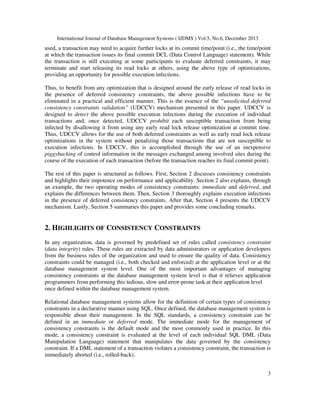
![International Journal of Database Management Systems ( IJDMS ) Vol.5, No.6, December 2013
2.1 Deferred Constraints
Unlike the immediate mode, when a consistency constraint is defined in deferred mode, it is
evaluated at the commit time of the transaction. Thus, the consistency constraint is evaluated at
the transaction level instead of each individual DML statement. At commit time of a transaction,
all deferred constraints that governs the data manipulated by the transaction are evaluated. If any
of the constraints is violated, the transaction is aborted. Otherwise, the transaction is allowed to
commit. The SQL standards incorporate the deferred mode for evaluating consistency constraints
for two essential reasons:
I.
Performance: deferred constraints enhance system performance when transactions tend to
abort because of users’ requests to abort or because of congestion over the system resources
(other than the locks on data). Thus, in such systems, by using deferred constraints, the
system can avoid wasting computing resources on evaluating consistency constraints at the
level of individual DML statements for transactions that will most probably end up aborting
before reaching their final commit points. Similarly, system performance is enhanced when
inserting (or loading) large amounts of data associated with consistency constraints into the
database.
II. Applicability: deferred constraints solve the problem of “cyclic consistency constraints” [19].
This problem arises whenever there is a circular chain of referential consistency constraints
between two or more relations (i.e., tables). Once exist, it is impossible to insert any tuple
(i.e., row or record) into any of the relations unless a method is used to temporarily breaks the
chain.
Next, the above two reasons are discussed in further details.
2.1.1. Performance of Deferred Constraints
In deferred mode, any locks that are exclusively needed for the evaluation of a deferred
consistency constraint are acquired at commit time of transactions. This is in contrast with
immediate constraints where all the locks needed for the execution of a DML statement are
acquired during the execution of the DML statement. This includes any exclusively needed locks
for the evaluation of the consistency constraint. Thus, there is a clear trade-off between the two
modes of consistency constraints. Deferred constraints hold the locks that are exclusively needed
to evaluate the constraints for shorter periods of time compared with immediate constraints,
allowing for more concurrency in the system. This is besides not wasting any time on evaluating
the constraints during the execution of a transaction until the transaction issues its final commit
statement. On the other hand, deferred constraints introduce the risk of conflicts among
concurrently executing transactions at commit time. This is due to the contention over the locks
that are exclusively needed to evaluate the deferred constraints compared with immediate
constraints where all needed locks are acquired during execution time (before reaching the final
commit point). This increases the possibility of transactions that are associated with deferred
constraints to abort at commit time after they have already consumed all the required computing
resources for their execution.
Based on the above trade-off, it can concluded that deferred constraints significantly enhance the
system performance when transactions tend to abort because of users’ requests to abort or
4](https://image.slidesharecdn.com/ondeferredconstraintsindistributeddatabasesystems-140108050339-phpapp01/85/On-deferred-constraints-in-distributed-database-systems-4-320.jpg)
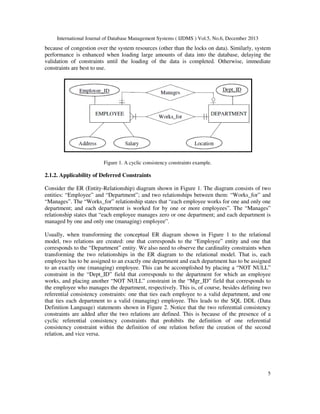
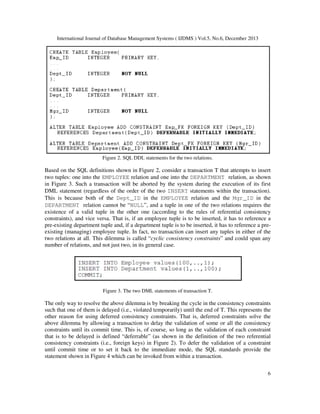
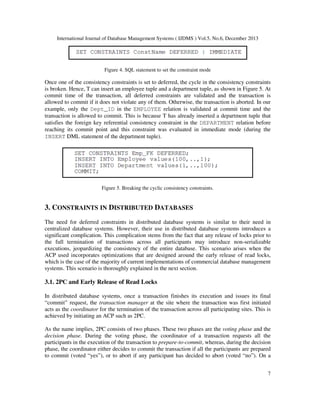
![International Journal of Database Management Systems ( IJDMS ) Vol.5, No.6, December 2013
commit decision, the coordinator sends out commit messages to all participants whereas, on an
abort decision, it sends out abort messages to only those (required) participants
that are prepared to commit (voted “yes”). When a participant receives a decision, it enforces the
decision and sends back an acknowledgment.
When a participant receives a prepare-to-commit message for a transaction, it validates the
transaction with respect to data consistency. If the transaction can be committed, the participant
responds with a “yes” vote. Otherwise, the participant responds with a “no” vote and aborts the
transaction, releasing all the resources held by the transaction including the locks held on behalf
of the transaction.
When the coordinator receives acknowledgments from all the participants that had voted “yes”, it
forgets the transaction by discarding all information pertaining to the transaction from its protocol
table that is kept in main memory.
The resilience of 2PC to system and communication failures is achieved by recording the
progress of the protocol in the logs of the coordinator and the participants. Specifically, the
coordinator of a transaction force-writes a decision record for the transaction prior to sending out
its final decision to the participants. Since a forced write of a log record causes a flush of the log
onto a stable storage that survives system failures, the final decision is not lost if the coordinator
fails. Similarly, each participant force-writes a prepared record before sending its “yes” vote and
a decision (i.e., either commit or abort) record before acknowledging a final decision. When the
coordinator completes the protocol, it writes a non-forced end record in the volatile portion of its
log that is kept in main memory. This record indicates that all (required) participants have
received the final decision and none of them will inquire about the transaction’s status in the
future. Hence, allowing the coordinator to (permanently) forget the transaction, with respect to
the 2PC protocol, and to garbage collect the log records of the transaction when necessary.
3.1.1. The Read-Only Optimization
The read-only optimization significantly reduces the cost of 2PC for read-only transactions. This
is because any exclusively read-only participant, a participant that has not performed any updates
to data at its site on behalf of a transaction, can be completely excluded from the decision phase
of the transaction.
Specifically, in this optimization, when a read-only participant in the execution of a transaction
receives a prepare-to-commit message, it simply releases all the locks held by the transaction and
responds with a “read-only” vote (instead of a “yes” vote). This vote means that the transaction
has read consistent data and the participant does not need to be involved in the second phase of
the protocol because it does not matter whether the transaction is finally committed or aborted.
Consequently, this optimization allows each read-only participant to terminate and to release all
the resources held by the transaction, including the read-locks, earlier than its update counterparts
and without having to write any log records. This represents the essence of the traditional readonly optimization [14].
8](https://image.slidesharecdn.com/ondeferredconstraintsindistributeddatabasesystems-140108050339-phpapp01/85/On-deferred-constraints-in-distributed-database-systems-8-320.jpg)
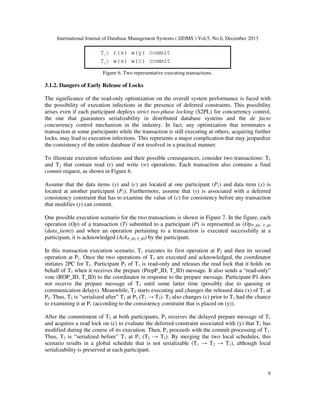
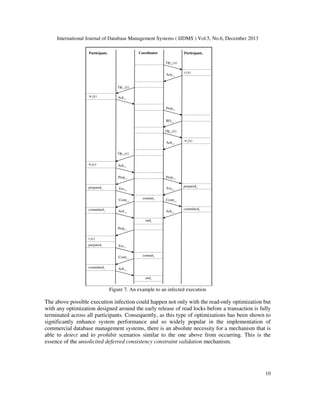
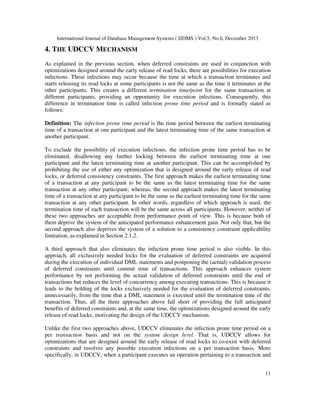
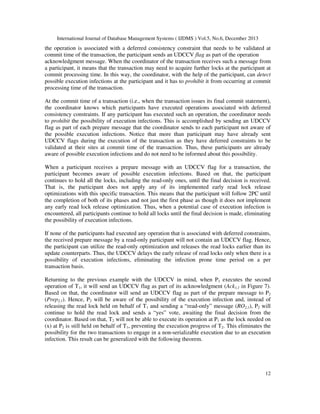
![International Journal of Database Management Systems ( IJDMS ) Vol.5, No.6, December 2013
Theorem: In any distributed database system that is based on a request/reply paradigm and
implements deferred consistency constraints, the UDCCV mechanism guarantees infection-free
executions of transactions when combined with S2PL and an ACP that incorporates an
optimization designed around the early release of read locks.
Proof: The proof proceeds by contradiction and consists of two parts.
For an execution infection to occur, there has to be a lock on a data item (d) that is released by a
transaction Ti before its commit point at some participant P and (d) is locked and modified by
another transaction Tj which commits before Ti in the global serialization schedule as follows:
locki(d) < lockj(d) and Tj → Ti
I. If locki is a “write” lock then it is impossible for Tj to acquire a lock on (d) and reaches its
commit point before Ti reaches its commit point first because, in S2PL with an ACP, the write
locks are released after transactions are terminated across all participants.
II. If locki is a “read” lock then it is possible for Tj to acquire a lock on (d) and reaches its commit
point before Ti terminates across all participants according to any early read lock release
optimization incorporated in the ACP used and not S2PL. But, as UDCCV is used, locki cannot
be released until Ti terminates across all participants. Thus, it is impossible for Tj to precede Ti in
the serialization order.
4.1. The UDCCV Mechanism and Other Optimizations
The UDCCV can be used with other optimizations designed around early release of read locks
such as early release of read locks (ERRL) [17] and the unsolicited update vote (UUV) [20, 21].
In ERRL, a participant in a transaction execution does not have to be an exclusively read-only
participant for it to release the read locks held on behalf of the transaction at prepare time of the
transaction. That is, in ERRL, each update participant is also allowed to release the read locks
held on behalf of a transaction once it receives the prepare message for the transaction.
UUV is another read-only optimization that further reduces the costs associated with read-only
participants. In UUV, each transaction starts as a read-only transaction at each participant and
when the transaction executes the first operation that updates data at a participant, the participant
sends an unsolicited update-vote. The “unsolicited update-vote” is a flag that is sent as part of the
operation acknowledgment. Thus, at the end of a transaction, the coordinator precisely knows all
update participants and infers that the rest of the participants are read only. In contrast to the
traditional read-only optimization, this is accomplished, in UUV, without having to explicitly pull
the vote of each participant. Consequently, the coordinator only needs to inform each read-only
participant that the transaction has terminated without requiring the participant to send back any
reply message, reducing the number of messages with read-only participants, compared with the
traditional read-only optimization, to the half.
The UDCCV mechanism can be used in conjunction with ERRL in a manner similar to its use
with the traditional read-only optimization. That is, when a participant executes an operation that
is associated with a deferred constraint, the participant sends an UDCCV flag as part of the
successful operation acknowledgment. This flag informs the coordinator about a possible
13](https://image.slidesharecdn.com/ondeferredconstraintsindistributeddatabasesystems-140108050339-phpapp01/85/On-deferred-constraints-in-distributed-database-systems-13-320.jpg)
![International Journal of Database Management Systems ( IJDMS ) Vol.5, No.6, December 2013
execution infection. Consequently, at commit processing time, the coordinator informs each other
participant about this possibility using an UDCCV flag that it sends as part of each prepare
message. Once a participant receives such a flag, it continues to hold the read locks until the end
of the commit protocol (i.e., the second phase of the protocol). If the transaction does not perform
any operation that is associated with deferred constraints, the participants can still utilize ERRL
as usual. Thus, UDCCV prevents possible execution infections only with transactions that are
associated with deferred constraints while still able to utilize ERRL with the other transactions.
The UDCCV mechanism can be also used in conjunction with UUV but in a slightly different
manner than its use with the traditional read-only optimization. This is because, in UUV, a
coordinator does not pull the votes of read-only participants through prepare messages.
Consequently, in the case of possible execution infections, the coordinator cannot request from
any participant to continue to hold the read locks until the commit decision is made. Instead, the
coordinator delays the termination message, which is called “read-only” in UUV, that it is
supposed to send to each read-only participant until after it has received the votes of the update
participants and made the final decision for the transaction. Thus, ensuring full termination of
transactions across all participants before any locks are released. Similar to the previous two
optimizations, in UUV, the UDCCV mechanism is used on a per transaction basis and only in the
presence of potential execution infections.
5. SUMMARY AND CONCLUSIONS
The most commonly adopted atomic commit protocol (ACP) optimizations in the database
standards and commercial database management systems are those designed around the early
release of read locks. However, when this type of optimizations is used in conjunction with
deferred consistency constraints that are evaluated at commit time of transactions, execution
infections may occur. These infections could lead to non-serializable executions of transactions,
jeopardizing the consistency of the entire database. Thus, there is a need for global
synchronization mechanisms to detect execution infections and to prohibit them from occurring.
The unsolicited deferred consistency constraints validation (UDCCV), presented in this paper,
represents one such mechanism.
The UDCCV mechanism relies on the piggybacking of control information among all involved
database sites in a transaction’s execution to detect and to prohibit any execution infection.
Hence, UDCCV allows for the use of deferred consistency constraints while eliminating possible
execution infections when adopting those widely advocated ACP optimizations that are designed
around the early release of read locks. UDCCV achieves this on a per transaction basis and
without adding any extra cost to the coordination messages and log writes of the used ACP.
REFERENCES
[1]
[2]
Gray, J. (1978) “Notes on Database Operating Systems”, in Bayer, R., R.M. Graham & G.
Seegmuller, (Eds.), Operating Systems: An Advanced Course, LNCS, Vol. 60, pp.393–481, SpringerVerlag.
Lampson, B. (1981) “Atomic Transactions”, in Lampson, B., M. Paul & H.J. Siegert, (Eds.):
Distributed Systems: Architecture and Implementation – An Advanced Course, Vol. 105, pp.246–
265, Springer-Verlag.
14](https://image.slidesharecdn.com/ondeferredconstraintsindistributeddatabasesystems-140108050339-phpapp01/85/On-deferred-constraints-in-distributed-database-systems-14-320.jpg)
![International Journal of Database Management Systems ( IJDMS ) Vol.5, No.6, December 2013
[3]
[4]
[5]
[6]
[7]
[8]
[9]
[10]
[11]
[12]
[13]
[14]
[15]
[16]
[17]
[18]
[19]
[20]
[21]
Al-Houmaily, Y. (2010) “Atomic Commit Protocols, their Integration, and their Optimisations in
Distributed Database Systems”, Int’l J. of Intelligent Information and Database Systems, Vol. 4, No.4,
pp. 373-412.
Chrysanthis, P., G. Samaras & Y. Al-Houmaily (1998) “Recovery and Performance of Atomic
Commit Processing in Distributed Database Systems”, (Chapter 13), in Kumar, V. & M. Hsu (Eds.),
Recovery Mechanisms in Database Systems, Prentice Hall.
Lee, I. & H. Yeom (2002) “A Single Phase Distributed Commit Protocol for Main Memory Database
Systems”, in Proc. of the 6th Int’l Parallel and Distributed Processing Symposium.
Ayari, B., A. Khelil & N. Suri (2011) “On the Design of Perturbation-Resilient Atomic Commit
Protocols for Mobile Transactions”, ACM Transactions on Computer Systems, Vol. 29, No. 3,
pp.7:1–7:36.
Nouali-Taboudjemat, N., F. Chehbour & H. Drias (2010) “On Performance Evaluation and Design of
Atomic Commit Protocols for Mobile Transactions”, Distributed and Parallel Databases, Vol. 27, No.
1, pp. 53-94.
Obermeier, S., S. Böttcher, M. Hett, P. Chrysanthis & G. Samaras (2009) “Blocking Reduction for
Distributed Transaction Processing Within MANETs”, Distributed and Parallel Databases, Vol. 25,
No. 3.
Haritsa, J., K. Ramamritham & R. Gupta (2000) “The PROMPT Real-Time Commit Protocol”, IEEE
Transactions on Parallel and Distributed Systems, Vol. 11, No. 2.
Qin, B. & Y. Liu (2003) “High Performance Distributed Real-Time Commit Protocol”, J. of Systems
and Software, Vol. 68, No. 2.
Shanker, U., M. Mesra & A. Sarje (2008) “Distributed Real Time Database Systems: Background and
Literature Review”, Distributed and Parallel Databases, Vol. 23, No. 2, pp. 127-149.
Rocha, T., A-B. Arntsen, A. Eidsvik, M. Toledo & R. Karlsen (2007) “Promoting Levels of Openness
on Component-Based Adaptable Middleware”, in Proc. of the 6th Int’l Workshop on Adaptive and
Reflective Middleware.
Al-Houmaily, Y. (2013) “An Intelligent Adaptive Participant’s Presumption Protocol for Atomic
Commitment in Distributed Databases”, Int’l J. of Intelligent Information and Database Systems, Vol.
7, No. 3, pp. 242-277.
Mohan, C., B. Lindsay & R. Obermarck (1986) “Transaction Management in the R* Distributed Data
Base Management System”, ACM TODS, Vol. 11, No. 4, pp. 378-396.
X/Open Company Limited (1991) “Distributed Transaction Processing: The XA Specification”,
(X/Open Doc. No. XO/CAE/91/300).
Samaras, G., G. Kyrou & P. Chrysanthis (2003) “Two-Phase Commit Processing with Restructured
Commit Tree”, in Proc. of the Panhellenic Conf. on Informatics, LNCS, Vol. 2563, pp.82–99.
Lomet, D. (1993) “Using Timestamping to Optimize Two Phase Commit”, in Proc. of the 2nd
Parallel and Distributed Information Systems.
ISO (2008) “Information Technology - Database Languages - SQL - Part 2: Foundation
(SQL/Foundation)”, ISO/IEC 9075-2.
Garcia-Molina, H., J. Ullman & J. Widom (2008) “Database Systems: The Complete Book”, 2nd
edition, Prentice-Hall.
Al-Houmaily, Y., P. Chrysanthis & S. Levitan (1997) “Enhancing the Performance of Presumed
Commit Protocol”, in Proc. of the 12th ACM Annual Symposium on Applied Computing.
Al-Houmaily, Y., P. Chrysanthis & S. Levitan (1997) “An Argument in Favor of the Presumed
Commit Protocol”, in Proc. of the 13th ICDE.
15](https://image.slidesharecdn.com/ondeferredconstraintsindistributeddatabasesystems-140108050339-phpapp01/85/On-deferred-constraints-in-distributed-database-systems-15-320.jpg)
